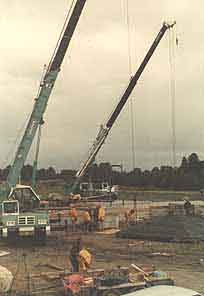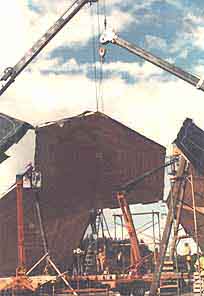 |
 |
|
|
Here in New Zealand with
a small market and a lower level of technological development we need a
different approach to geodesics. We must look at what technology is available
and develop building systems to suit.
If we were at 'mud hut' level we could build geodesics out of vines and sticks, lashed with flax to make a basket and then covered with a mud and straw mixture, or with traditional straw thatch. We're about half way between the mud hut and the space shuttle Columbia. 
What is available, with a well developed infrastructure, is a building industry well used to using timber based products. This means power saws, planers, air-nailing guns, glue, panel products etc. There is a definite morality about using timber to build houses. Timber is this planet's only renewable resource. Other structural materials are often dependant upon nuclear or fossil fuel based energy systems -and one day we must pay the price of using this "cheap" energy. 
I have called the method I have developed for geodesics the J.Rich Dome System. The system offers the following advantages,
especially related to N.Z.
Further details of the J.Rich Dome System appear
under "HOUSES".
DesignJ.W.Rich offers a complete design service for geodesic domes. Depending upon the scope of the work a fee between 5% and 8% is charged subject to the following conditions.1. The Designer will provide preliminary advice, costings and design, once the design has been decided, plans and documentation as required for Resource Consent from the local Council. Once Resource Consent has been obtained then final design, calculations, specifications and documentation for a building permit (all in accordance with the agreed conceptual design), and once the building permit has been received, plans, details and geometry for construction purposes. The Designer will also provide cost breakdowns, schedules of quantities and a construction programme as well as on-going advice as needed, within reason, throughout the construction period, including advice on material supply and sub-contracts. 2. The Designer will be responsible for resource
consent applications, site survey, geotechnic survey/report and engineer's
design certificate.
3. The Owner acknowledges and agrees that the Designer is the proprietor of the J.Rich Dome System and accepts that the Owner is being granted a licence to use the J.Rich Dome System for this project only, and the Owner undertakes not to disclose any of the construction details to others unless he has the Designer's prior written and specific consent. 4. The Owner acknowledges that the Designer shall
be engaged to supervise the erection of the dome and that the Designer
shall supply the hubs required for the erection.
ErectionIf J.W.Rich designs a dome then he generally insists on supervising the erection of the dome. This usually takes one day of preparation, one day to erect, one day to tidy up and one more day to set the builder right about the rest of the project, thus four days. J.W.Rich charges a day rate of between $300 and $400 plus travel and accommodation expenses. The hubs are also supplied, and depending upon the complexity of the dome, cost between $350 and $800.The favoured erection technique is over head with a crane or a centre pole. The following sketches show this method using a pole for a 3v oblate superellipsoidal icosahedron with the vertical walls already in place to sit the dome on.. 
Domes can also be erected by making up clusters of triangles, hexs and pents, and craning them into place, propping the dome as you go. The pictures below show a 48m x 36m 3v stretched and squashed superellipsoidal icosahedron being erected by this method.   
The Cinema 180 Dome at Rainbow's End Fun Park near Auckland, N.Z., was a design and build project. It was erected in 11 hours with a crew of 14 men and a crane. It was not just one dome, it was a 15.6m diameter 4v icosahedron spheroid inside an 18m diameter 4v icosahedron spheroid, and both domes were erected together, the inner dome hanging from the crane and the outer dome strutted from the inner one. The outer dome was then covered with perspex of different shades of blue, and backlit to make it glow like a blue ball at night. The inner dome shell was plastered with a super lightweight cement and polystyrene bead mixture. The plaster was applied over 3 layers wire netting and made spherical to be the screen for the Cinema 180 and it's bug-eye lens projector. A more mundane feature of the design was the drain in the centre of the dished floor, which was carpeted with polyester swimming pool carpet. This was so the floor could be hosed down after the inevitable motion sickness felt by some patrons when watching Cinema 180. MODELS (of domes, in case you thought otherwise) Building a model of your dome is an excellent way to come to terms with the spaces, the shapes and the erection sequences. The following three dome models were built by myself, Tony Whitton and Mark Verhoeven respectively. J.W.Rich offers a service to build models for clients, or in some cases have the models made by others. They cost between $300 and $2,500 (USD)depending on how detailed and complex they may be, the standard of finish required and whether there are internal views or cut-away sections.
I recently completed a dome model for the Naturmuseum Solothurn, in Switzerland. They are including it in a Biotek exhibition.   
|